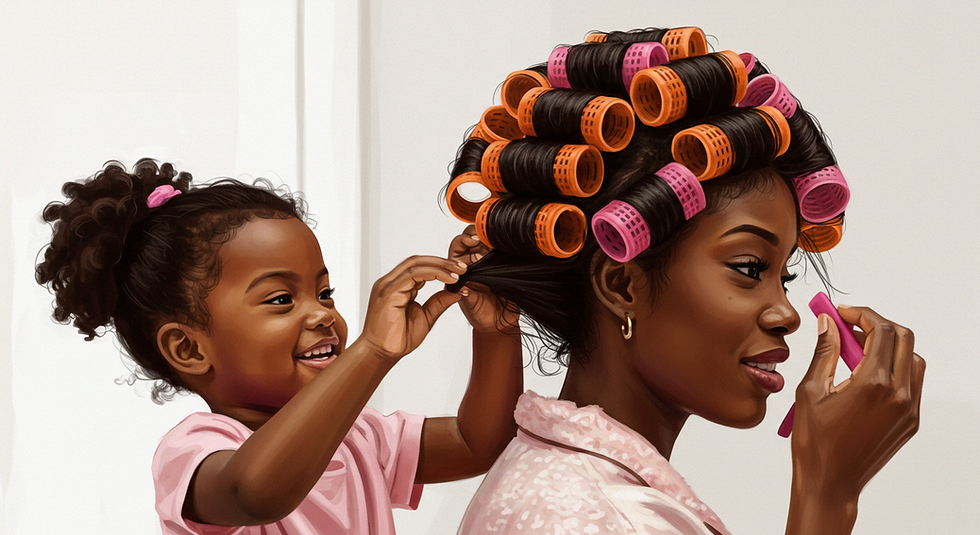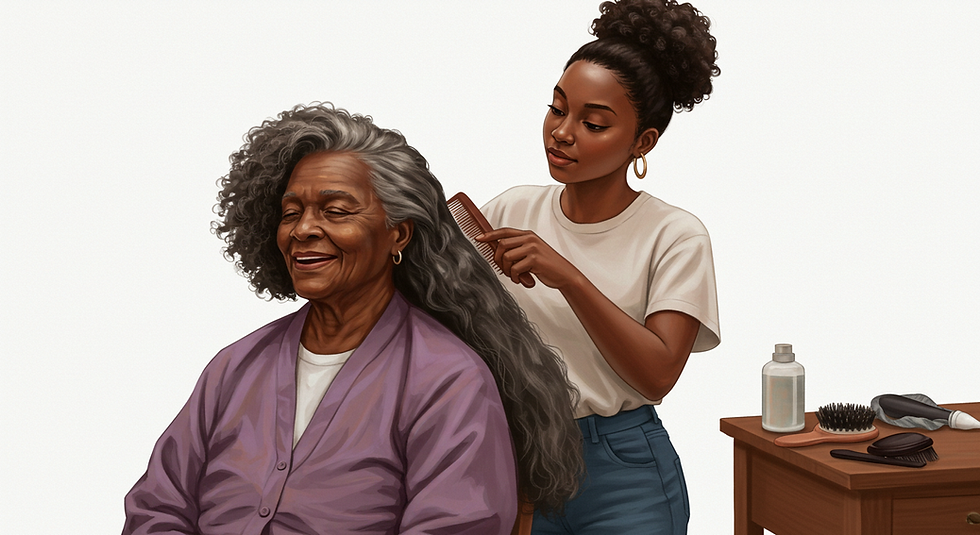What is the least damaging hairstyle for black women? Part 1
- The Editor
- Aug 14
- 7 min read
Updated: Sep 6

We know that for too long, the narrative around our hair has been riddled with misconceptions, societal pressures, and the burden of finding styles that don't compromise our health. But let's be clear: your hair is your crown, a powerful symbol of identity, culture, and self-expression. It deserves to be treated with the utmost care and respect.
The Unique Architecture of Afro-Textured Hair
To truly understand how to protect and nurture your hair, we must first appreciate its inherent characteristics. While all human hair shares a similar chemical structure, Afro-textured hair possesses distinct physical properties that set it apart from Caucasian and Asian hair types. Our strands are typically elliptical in shape, rather than circular or cylindrical, and feature frequent twists and random reversals in direction along the hair shaft, resulting in a pronounced flattening. This unique architecture makes Afro-textured hair more prone to knotting, tangling, and breakage, as these natural twists create points of vulnerability where the hair can easily fracture.
Beyond its shape, Afro-textured hair also exhibits differences in growth rate and density compared to other ethnic groups. The growth rate for African hair is approximately 280 µm/day, which is slower than Asian hair (411 µm/day) and Caucasian hair (367 µm/day). Similarly, hair density in African Americans is significantly lower, estimated at around 161 hairs/cm², compared to 175 hairs/cm² for Asian and 226 hairs/cm² for Caucasian hair. These characteristics, combined with a naturally lower moisture content and greater susceptibility to surface damage, mean that Afro-textured hair is inherently more fragile and prone to dryness and breakage. This scientific understanding is not about limitation, but about informed care—recognizing that our hair thrives with specific, gentle approaches tailored to its unique needs.
Unravelling the Legacy of Damaging Practices: A Historical Perspective
The quest for "manageable" or "desirable" hair among Black women is deeply rooted in a socio-historical context defined by Eurocentric beauty standards. Since the era of chattel slavery in the Americas, there has been immense pressure to straighten African hair, initially through practices like shaving heads upon arrival to dehumanize enslaved Africans, and later through hot combs and chemical straightening methods. The 20th century saw the widespread adoption of hot combs and chemical relaxers, perceived by some as a means to emulate European beauty standards, though others viewed it simply as a styling option.
This pursuit of straight hair, driven by societal norms that often deemed natural Black hair as "kinky," "nappy," "coarse," or "wooly" (terms that were, and still are, socially and politically constructed to signify inferiority), has come with significant health consequences. Chemical relaxers, which contain highly alkaline chemicals like sodium hydroxide (lye), work by breaking the disulfide bonds within the hair, permanently altering its structure. Millions of Black women use these products, often exposing themselves to various chemicals through scalp lesions and burns. Beyond immediate injuries like balding, burns, and colour change, the long-term use of chemical relaxers has been associated with more serious health concerns, including an increased incidence of uterine fibroids. While further research is needed, some studies have also explored potential links between hair dye and chemical straightener use and breast cancer risk, raising important questions about the long-term impact of these products. Even hot combing, a thermal straightening method using tools heated to 300 to 500°F (149 to 260°C), carries risks of thermal burns to the scalp, ears, and neck, and can lead to excessive hair damage.
Beyond physical harm, the constant pressure to conform has significant psychosocial impacts. Hair has been, and continues to be, symbolic of both power relations and resistance. To wear natural Black hair can be a political act, often deemed socially and politically unacceptable in various environments, especially corporate settings. This "hair-ism" has led to feelings of negative self-regard and impacts social, economic, and political aspects of Black women's lives. The internalisation of beliefs that natural hair is "bad" can cause psychological trauma, impacting self-esteem and identity development from a young age. This cultural burden is so profound that nearly half of African American women report avoiding exercise due to concerns about their hairstyles, a significant barrier to physical activity and healthy weight management in an already high-risk population. This reveals a critical intersection of hair, health, and identity, highlighting why informed choices about our hair are deeply empowering.
Recognising the Signs: Common Hair and Scalp Disorders
Understanding the physical consequences of certain styling practices is key to preventing long-term damage. Here are some of the most common hair and scalp disorders prevalent in Black women:
Traction Alopecia (TA): This is a form of hair loss caused by chronic pulling or tension on the hair follicles, often resulting from tight hairstyles. It commonly occurs along the crown of the scalp. Studies estimate a prevalence of up to 32% among Black women, with those using relaxed hair being more than 3.5 times more likely to develop TA. Key risk factors include tight ponytails, braids, cornrows, and the use of hair extensions or weaves, especially when done too tightly or left in for prolonged periods. The constant tension physically damages the hair follicle, which can lead to permanent scarring if not addressed.
Acquired Trichorrhexis Nodosa (ATN): Characterised by recurrent hair breakage, ATN occurs when the hair shaft is repeatedly subjected to damaging practices. Common culprits include chemical relaxers, frequent thermal styling (like hot combs and flat irons), and excessive hair colouring. Patients often complain of a lack of hair growth, which is actually due to the hair breaking off.
Central Centrifugal Cicatricial Alopecia (CCCA): This is the most commonly cited hair disorder in women of African descent, and it is a scarring alopecia, meaning it can lead to permanent hair loss. While its exact cause is still being investigated, CCCA has been linked to both chemical relaxants and traction styles. The damage in CCCA is often progressive, requiring early recognition and intervention to halt its progression.
Seborrheic Dermatitis (SD): This common scalp condition can also be exacerbated by certain hair practices. Research indicates that hair extensions and infrequent hair oil use are significantly related to SD. The tightly coiled nature of Black hair can impede sebum from travelling down the hair shaft, leading to oil buildup on the scalp, which creates an ideal environment for the overgrowth of Malassezia yeast, a common factor in SD development. While hair oils can be beneficial for lubrication, excessive or improper use can increase the incidence of SD.
The Path to Healthier Hair: Embracing Low-Damage Practices
The good news is that with increased awareness and intentional choices, we can significantly reduce the risk of hair damage. The scientific consensus points towards natural styles (hair that is not chemically or thermally straightened) as having the fewest adverse associations with hair and scalp disorders. The rising popularity of natural hair, no longer solely a political statement but an embrace of self-acceptance and health, is a testament to this shift.
When considering what is least damaging, the method of styling is as crucial as the style itself. Here are the cornerstones of low-damage hair care for Black women:
Loose Protective Styles: Styles like braids, twists, and dreadlocks are often celebrated for their low maintenance and chemical-free nature, reducing the need for daily manipulation. They can also be effective for transitioning from chemically treated hair to natural hair. The key, however, lies in ensuring they are loose and not causing excessive tension on the scalp or hair follicles. When braiding, ensure there is enough space between braids to allow you to touch your scalp, as this is essential for proper washing and preventing dirt accumulation. Hair extensions or weaves, when used, should also be loosely sewn in and not excessively long to minimize tension. Limiting the application of extensions to 3-4 weeks before alternating to natural styles is recommended. It's also vital to never cut your natural hair when removing braids or extensions. Wigs can also be a protective style, covering natural hair and reducing manipulation. Opt for silk caps underneath to reduce friction and apply emollients to your natural hair to maintain moisture.
Minimising Chemical Treatments: The decline in relaxer sales since 2006 indicates a growing awareness of their potential harm. If chemical treatments are chosen, they should be applied by experienced professionals who understand proper technique and processing times, and ideally spaced out by days to weeks from colouring to decrease damage potential.
Judicious Heat Styling: While hot combs and flat irons offer temporary straightening, their high temperatures can cause significant damage, including acquired trichorrhexis nodosa and "bubble hair". If heat must be used, do so sparingly and with appropriate heat protectants.
Consistent Cleansing and Moisturising: Regular washing, ideally every 1-2 weeks, is crucial for maintaining scalp health and preventing conditions like seborrheic dermatitis. Use a mild shampoo and gently massage the scalp between braids if styled. Given the natural dryness of Afro-textured hair, consistent moisturising is paramount to prevent breakage. While hair oils lubricate, avoid overuse if you are prone to seborrheic dermatitis, as tight curls can impede sebum flow, potentially leading to buildup.
Ultimately, the journey to healthy hair is a personal one, but it is one you embark on with the power of knowledge. By understanding the unique properties of your hair and adopting practices that prioritize its health—gentle handling, appropriate protective styling, and mindful use of products—you can truly embrace the beauty and strength of your natural crown, free from the constraints of damaging norms.
Read More:
Selected References
Asbeck, S., Riley-Prescott, C., Glaser, E. & Tosti, A. (2022) Afro-Ethnic Hairstyling Trends, Risks, and Recommendations. Cosmetics, 9:17.
Mbussuh Nzeng, L. F., Nguefack-Tsague, G., Kotto, R., Tounouga, D. N., Sigha, O. B., Nkoro, G. A., Nida, M. & Kouotou, E. A. (2023) Hair Care and Epidemiological-Clinical Profile of Traction Alopecia Among Women in Hair Salons in Yaoundé, Cameroon. Skin Health and Disease, 3(1):e158.
Quaresma, M. V., Martinez Velasco, M. A. & Tosti, A. (2015) Hair Breakage in Patients of African Descent: Role of Dermoscopy. Skin Appendage Disorders, 1, 99–104.
Rucker Wright, D., Gathers, R., Kapke, A., Johnson, D. & Joseph, C. L. M. (2011) Hair care practices and their association with scalp and hair disorders in African American girls. Journal of the American Academy of Dermatology, 64(2), 253–262.
Tanus, A., Oliveira, C. C. C., Villarreal, D. J. V., Sanchez, F. A. V. & Dias, M. F. R. G. (2015) Black women’s hair: the main scalp dermatoses and aesthetic practices in women of African ethnicity. Anais Brasileiros de Dermatologia, 90(4), 450–465.


